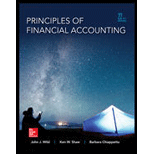
Assign the joint land and improvement costs to the lots using the value basis of allocation and determine the average cost per lot.
Explanation of Solution
Joint cost: The total cost incurred to produce or manufacture or process, more than two products at the same time, is referred to as joint cost.
Allocation of joint costs:
- Physical basis of allocation: In this method, joint costs are allocated when the number of units, or pounds, or square feet, cubic feet, gallons used by individual products, can be compared and measured with the total number of units, or pounds, or square feet, cubic feet, gallons used by the total products.
- Value basis of allocation: In this method, the joint costs are allocated to the value of sales revenue generated by number of units of individual products, can be compared and measured to the sales revenue generated by total number of units.
Allocate the joint land and improvement costs to the lots using the value basis of allocation and calculate the average cost per lot:
| Particulars | Market Value | % of total | Allocated cost | Average lot cost |
| Canyon section | $24,750,000 (1) | 60% (2) | $4,500,000 (4) | $10,000 (6) |
| Hilltop section | $16,500,000 (1) | 40% (3) | $3,000,000 (5) | $20,000 (7) |
| Total | $41,250,000 (1) | 100% | $7,500,000 |
Table (1)
Note: Allocated cost-value basis of allocation is $7,500,000
Working note:
Calculate the total market value of lots:
| Lots | Quantity | Price | Total |
| Canyon | 450 lots | $55,000 | $24,750,000 |
| Hilltop | 150 lots | $110,000 | $16,500,000 |
| Total market value | $41,250,000 |
Table (2)
…… (1)
Calculate the percentage of allocation for canyon section:
Calculate the percentage of allocation for hilltop section:
Calculate the cost allocated to canyon section:
Calculate the cost allocated to hilltop section:
Calculate the average lot cost of canyon section:
Calculate the average lot cost of hilltop section:
Want to see more full solutions like this?
Chapter 24 Solutions
Principles of Financial Accounting.
- Ardor Ltd. purchased a new equipment that is expected to be used in operations for 6 years for $60,000. The salvage value of the equipment after 6 years is $6,000. Assume the equipment was purchased on the first day of the fiscal year so no partial-year depreciation is needed. Using the Straight-Line Depreciation Method, what is the value of accumulated depreciation at the end of year 4?arrow_forwardGeneral Accountingarrow_forwardPlease help me solve this general accounting problem with the correct financial process.arrow_forward
- I am trying to find the accurate solution to this financial accounting problem with the correct explanation.arrow_forwardKD Industries has 30 million shares outstanding with a market price of $20 per share and no debt. KD has had consistently stable earnings and pays a 35% tax rate. Management plans to borrow $200 million on a permanent basis through a leveraged recapitalization in which they would use the borrowed funds to repurchase outstanding shares. The present value of KD's interest tax shield is closest to a. $130 million b. $200 million c. $400 million d. $70 millionarrow_forwardCorrect answer please general accountingarrow_forward

 AccountingAccountingISBN:9781337272094Author:WARREN, Carl S., Reeve, James M., Duchac, Jonathan E.Publisher:Cengage Learning,
AccountingAccountingISBN:9781337272094Author:WARREN, Carl S., Reeve, James M., Duchac, Jonathan E.Publisher:Cengage Learning, Accounting Information SystemsAccountingISBN:9781337619202Author:Hall, James A.Publisher:Cengage Learning,
Accounting Information SystemsAccountingISBN:9781337619202Author:Hall, James A.Publisher:Cengage Learning, Horngren's Cost Accounting: A Managerial Emphasis...AccountingISBN:9780134475585Author:Srikant M. Datar, Madhav V. RajanPublisher:PEARSON
Horngren's Cost Accounting: A Managerial Emphasis...AccountingISBN:9780134475585Author:Srikant M. Datar, Madhav V. RajanPublisher:PEARSON Intermediate AccountingAccountingISBN:9781259722660Author:J. David Spiceland, Mark W. Nelson, Wayne M ThomasPublisher:McGraw-Hill Education
Intermediate AccountingAccountingISBN:9781259722660Author:J. David Spiceland, Mark W. Nelson, Wayne M ThomasPublisher:McGraw-Hill Education Financial and Managerial AccountingAccountingISBN:9781259726705Author:John J Wild, Ken W. Shaw, Barbara Chiappetta Fundamental Accounting PrinciplesPublisher:McGraw-Hill Education
Financial and Managerial AccountingAccountingISBN:9781259726705Author:John J Wild, Ken W. Shaw, Barbara Chiappetta Fundamental Accounting PrinciplesPublisher:McGraw-Hill Education





